Idea in Brief
Wellness programs are becoming more prevalent in society as healthcare providers try to lower costs of chronic diseases, employers strive for a healthy workforce, and individuals become motivated to take control of their own health through technological advances that quantify wellness. While there are many differences in the details of each wellness program, most have similar objectives: increase engagement and participation to improve health.
Three key components support most wellness programs:
- An initial Health Risk Assessment (HRA) that provides health information to individuals to measure their baseline health status.
- Health tracking/analysis tools that provide ongoing, individualized data and allow for setting measurable goals and tracking progress.
- Incentives to attract new participants and maintain current participant engagement.
Program effectiveness is difficult to measure. However, evidence suggests that effective wellness programs that focus on improving lifestyle behaviors such as reducing smoking, improving diet and increasing physical activity can reduce the economic burden of chronic diseases. Most programs must be in force for at least five years before achieving measurable health benefits exceeding program costs.
Wellness programs are commonly part of corporate benefit packages, either as a supplement to health coverage or as an additional feature. Group benefit packages often include life and disability insurance policies; wellness programs could assist with the underwriting and pricing of these policies. One development in the wellness arena is premium discounts on individual protection. Coupling a life insurance policy with a wellness plan encourages consumers to take action to improve their personal health as well as reduce their premiums. The insurer may realize improved experience and be able to develop new and innovative products.
Background
Each year, 36 million people worldwide die from non-communicable diseases. These ailments, such as cardiovascular diseases, certain cancers, chronic respiratory disorders and diabetes, account for 63% of deaths worldwide and are largely the result of lifestyle choices. The World Health Organization attributes nearly all of these premature deaths to smoking, unhealthy diet, physical inactivity and harmful use of alcohol.[1] According to Ralph Keeney of Duke University, “The leading cause of death is personal decision making…. Making better personal decisions could potentially prevent millions of premature deaths per decade.”[2]
In addition to premature death, unhealthy lifestyles contribute to chronic conditions that affect a person’s quality of life and workforce productivity. Common chronic conditions such as back pain, depression, diabetes and obesity influence productivity through increased absenteeism as well as presenteeism, defined as underperforming at work due to illness or injury.[3] The World Economic Forum has identified the eight behaviors that contribute to the most costly chronic conditions: “smoking, physical inactivity, poor diet, alcohol consumption levels, poor standard-of-care compliance, poor stress management, insufficient sleep and lack of health screening.”[4]
Chronic conditions are a driving factor behind soaring healthcare costs, which are increasing nearly 8% annually worldwide[5] and are a concern for health insurers, employers and governments worldwide. As healthcare expenditures are becoming a larger portion of a country’s GDP, corporate expenditures and personal budgets, wellness programs are gaining popularity as a means to control the costs from chronic disease.
Wellness programs have proliferated in recent years. Health insurers may offer wellness programs to enhance traditional coverage. Additionally, companies specializing in wellness program offerings have emerged. Further, the “Quantified Self Movement” encourages individuals to participate in wellness through utilization of fitness apps and activity monitors.[6]
New developments are transforming the traditional wellness space. Desk jobs that previously resulted in hours of physical inactivity are now adapting with the invention of the standing desk and even a treadmill desk.[7] The company that produces a leading activity monitor, Fitbit, has a wellness program available for corporations to purchase.[8] Apple has collaborated with U.S. health insurers to integrate technology such as HealthKit and the much-anticipated Apple Watch with health insurance products.[9]
Incentivized wellness is being incorporated in individual protection insurance offerings as well. Innovative companies are developing products to encourage healthy behavior and offer premium discounts as part of an associated wellness program. The increased use of wellness programs has prompted considerable focus on their effectiveness. However, in order to gauge program effectiveness, it is important to understand there are significant differences in the types of wellness programs incentivized worldwide.
Wellness Program Offerings
The goal of most wellness programs is to encourage people to adopt a healthier lifestyle. As wellness programs become increasingly prevalent, similarities and differences in program offerings are emerging. One key difference in programs is how the program reaches the market. Health insurers may offer a wellness plan to enhance existing health coverage. Other companies, such as U.S.-based Keas and Sonic Boom, have developed wellness programs that are sold directly to employers.[10] [11] Their plans can be standalone or integrated into existing corporate wellness programs. A common wellness plan will include most, if not all, of these basic offerings: an initial health risk assessment (HRA), health tracking/analysis tools and incentives.
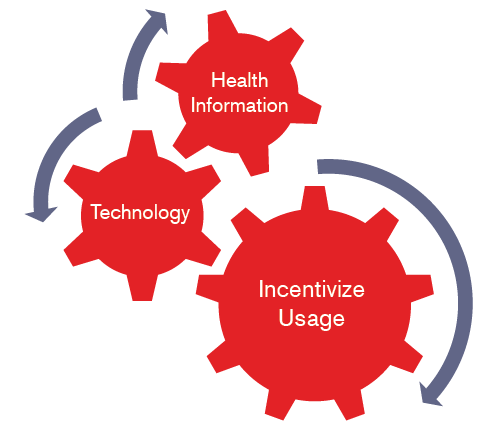
Health Information
Wellness programs often require participants to take a biometric screening or submit a Health Risk Assessment. One company specializing in these services is the U.K.-based, Road to Health, which markets and supports online health risk assessment, health risk management, clinical care and clinical management software solutions. After completing an online assessment, a Q Score is given. This Q Score lets individuals see how they compare with 100 people of the same age, race and gender. [12] Providing health information to individuals is important to improving wellness because many people believe they are healthier than they actually are. A recent survey by Aon Hewitt of 2,800 U.S. employers found that of the participants who completed an HRA that suggested a follow-up action, 86% took some action and 65% made at least one lifestyle improvement as a result of the HRA.[13] Raising awareness about health conditions can lead to overall improved health if unhealthy behaviors are adjusted as a result. Beyond health assessments, companies may have online health coaches to give program participants tailored health advice and assist them in setting goals.
Technology
Technology is playing an ever-increasing role in wellness programs. Activity trackers encourage fitness by quantifying steps and movement. These devices are widely available, and along with mobile apps to monitor fitness, sleep patterns and nutrition, bring individualized data to people. Obesity-related conditions could decline with consistent use of this new technology.
There is variability in the use of technology in wellness programs. Companies like Virgin Pulse and Fitkik have developed their own proprietary devices as the centerpiece to their programs.[14] [15] These gadgets track activities such as steps taken, distance traveled, calories burned and active minutes. These programs usually offer a differentiating feature, such as personal challenges between members. The use of third-party devices is a common option for wellness programs. This allows the users more flexibility to choose what device works best for them. The wellness companies Keas and Shapeup both allow for third-party fitness and biometric tracking device integration. [10] [16]
Incentives
Many wellness programs have an engagement strategy in place because program effectiveness improves with utilization. Psychologists often contribute to program design to encourage continued participation in healthy living. In 2013, Buck Consultants surveyed 360 large, multinational employers regarding wellness program participation strategies. Most employers in the survey utilized gamification, which scored the highest in perception of effectiveness in engaging employee participation. Social networking and rewards are also commonly used components to encourage continued healthy habits.[17]
Incentivizing participants is a major component of any wellness program, and the plans currently available vary widely in how they accomplish this. Incentives not only help attract new participants, but they can also help keep current participants actively engaged in the program. Incentive programs can be as simple as Fitbit’s online rewards that provide virtual badges for goals met or milestones achieved. [18] Other programs, including Shapeup, offer financial rewards, such as Amazon gift cards.[16]
Humana Vitality has gone even further by employing behavioral economics in its incentive program; the company created its own virtual shopping mall. Members of the program earn “Vitality Bucks” that they spend in the virtual mall. [19] This mall has a wide selection of purchasing options, such as movie tickets, hotel stays, digital cameras and Apple products.
There are many ways to create a more engaged group of participants in a wellness program. Since every participant group is different, it is not surprising to see so many variations in programs. What works for one program does not necessarily work for another. An effective wellness program recognizes the needs of each group and is dynamic enough to change when needed.
Effectiveness
Wellness programs can decrease healthcare costs and improve employee productivity; however, program effectiveness is very difficult to measure. In a survey of U.S. employers conducted by the RAND Corporation, employers generally perceive wellness programs to be effective in counteracting the costs of chronic illness, but few companies quantify this impact.[20]
The empirical studies that attempt to measure return on investment (ROI) often lack comparison or control groups. Additionally, comparisons may suffer from selection bias as healthy and motivated people disproportionately enroll in these voluntary programs. Another difficulty in quantifying wellness program effectiveness is measuring the behavioral change in individuals that can then filter through to families and communities. However, lower healthcare costs, improvements in major health risk factors, and productivity improvements can all contribute to the ROI in wellness programs.
Absenteeism and Presenteeism
Wellness programs can contribute to fewer missed work days. A study that examined employee absenteeism estimated that wellness programs can result in almost two fewer days absent per employee per year.[21] Additionally, results from a PricewaterhouseCoopers survey found that indirect costs, such as days missed at work, were approximately four times higher for individuals with chronic disease than for those without.[22]
Presenteeism is defined as an employee present at work but not fully performing or functioning because of illness or other medical conditions such as headaches, migraines, depression, backache and even heartburn. Lockheed Martin studied the impact of several medical conditions on workers’ productivity. The annual cost to the company due to lost productivity from these conditions was estimated at approximately $34 million in a year.[23]
Although difficult to measure, employees who are healthier and less stressed tend to be more productive.
Major Risk Factors
Programs that focus on improving physical activity can be effective in reducing the risk of cardiovascular disease.[24] Exercise promotion may be the most cost-effective element of a wellness program. Physical activity can be very effective in helping to treat depression, chronic pain, headaches, heart disease, high blood pressure and diabetes.[25] A study of the effectiveness of incentivized wellness programs found that members using these plans had higher levels of physical activity, which was associated with lower hospitalization rates and healthcare costs. [26]
Healthcare Costs
Many features of wellness programs target behaviors that may lead to cost savings that are not realized until the long term. For example, spending on hospitalizations may be replaced by increased spending for preventive care visits and at pharmacies. According to the RAND Corporation, there are two features common to wellness programs: lifestyle management and disease management. Spending on lifestyle management tends to take longer to achieve measurable cost savings, while efforts to reduce the impact of ailments from chronic diseases have a greater immediate impact on healthcare spending.[27]
There is no consensus on the savings provided by wellness programs. RAND Health’s Workplace Wellness Programs Study found that wellness programs focused on lifestyle management have a minimal impact on healthcare costs and that it takes an average of five years for a new wellness initiative to become cost neutral, let alone generate a positive ROI.[20] Conversely, a review conducted by Harvard found that medical costs fall about $3 for every dollar spent on wellness programs. Additionally, absentee costs fall by about $3 for every dollar spent.[21] However, studies that calculate the average return on investment from wellness programs do not reflect the wide range of effectiveness of wellness program offerings.[28]
Corporate Wellness Programs
All workplace wellness programs have similar goals: create happier, healthier employees to drive up productivity and decrease healthcare costs. The effectiveness of a wellness program may depend on the details of the program offerings. Successful corporate wellness programs have broad corporate support from senior managers and adapt to address the specific needs of employees.[29]
Wellness programs are often administered as part of a benefits package to employees either in conjunction with health insurance coverage or as part of a standalone wellness program. These benefits packages may include group life and disability insurance offerings. Wellness programs could inform dynamic underwriting and refine group pricing. However, an important consideration is the significant variation in corporate wellness program offerings.
Variations by Type of Business Operations
Corporations that offer wellness programs to their employees cover a wide spectrum of industries, including mining, hospitality, telecommunications and manufacturing. For many, the impetus to start these programs came from a health and safety perspective, with the concept of wellness added later. Other companies adopt a holistic approach that focuses on the employees’ mental health and well-being, the importance of a work life balance, and the employees’ handling of stress, together with their physical health.
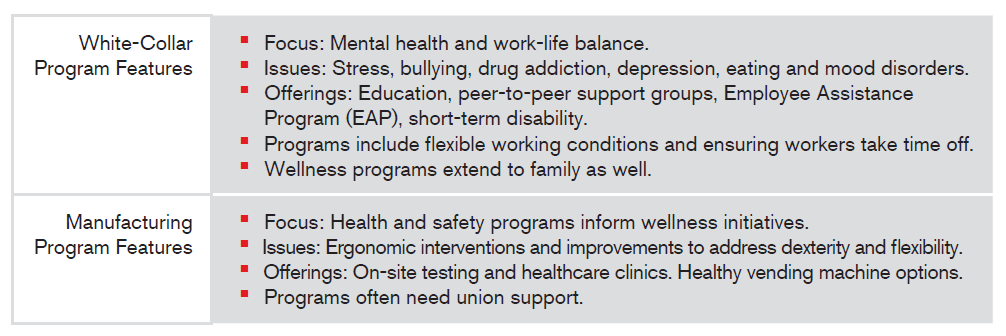
Cultural Differences
Companies that operate globally have found that one health and wellness program may not fit all and that diversity and cultural differences must be take n into account in the design of the health and wellness program in each location.
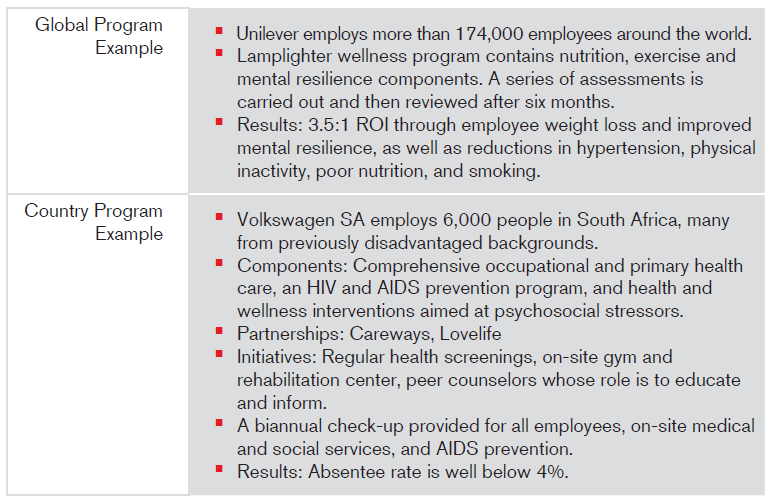
Sources: Unilever. Progress Report 2012. Unilever Sustainable Living Plan. [Online]http://www.unilever.co.uk/Images/USLPProgress-Report-2012-FI_tcm28-352007.pdf.
Volkswagen South Africa. People Behind the Volkswagen Wheel. [Online]http://www.vw.co.za/en/volkswagen_groupsouthafrica/about/people.html.
Differences Between Small Businesses and Large Corporations
Small businesses (defined as less than 100 employees) represent more than 98% of all employers in the U.S and Canada. [32] [33] The costs of running a wellness program include the direct costs of the program itself as well as the indirect costs of program staff and time. Because small businesses do not have the same resources to invest as large companies, the wellness programs offered to employees are often smaller in scale. The Wellness Council of America (WELCOA) is an organization that provides guidance and information on the steps needed for small businesses to produce a wellness program. [33]
Large companies, on the other hand, may have the financial capabilities to provide large-scale wellness offerings to employees, but must also address the diverse needs of employees. For example, SAS Institute Inc. provides an on-site medical clinic to employees.[34] British Telecom’s wellness program Workfit is designed to meet the needs of a diverse and changing employee group. Each year the theme of the Workfit program changes; program focus has included men’s health, smoking cessation, mental health, cancer awareness and physical activity.[35]
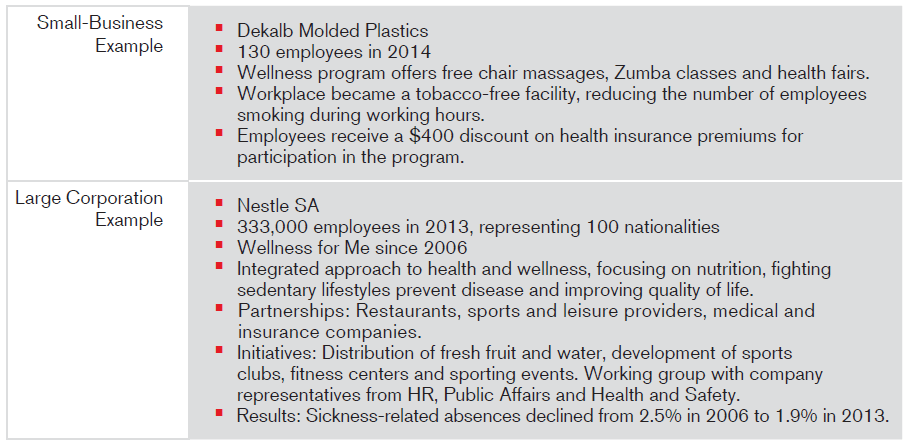
Sources: Todd-Gustafson and Associates. Customer Service and Employee Relations: Here’s Something Worth Noting. [Online]http://toddgus.com/blog/customer-service-and-employee-relations-heres-something-worth-noting.
World Economic Forum. CASE STUDY Nestlé. [Online]http://www3.weforum.org/docs/WEF_HE_Nestle_CaseStudy_2014.pdf.
Individual Protection Insurance: A Global Perspective
An extension of wellness programs is offering discounts on life insurance premiums. A few insurers are pioneering these product offerings in many parts of the world.
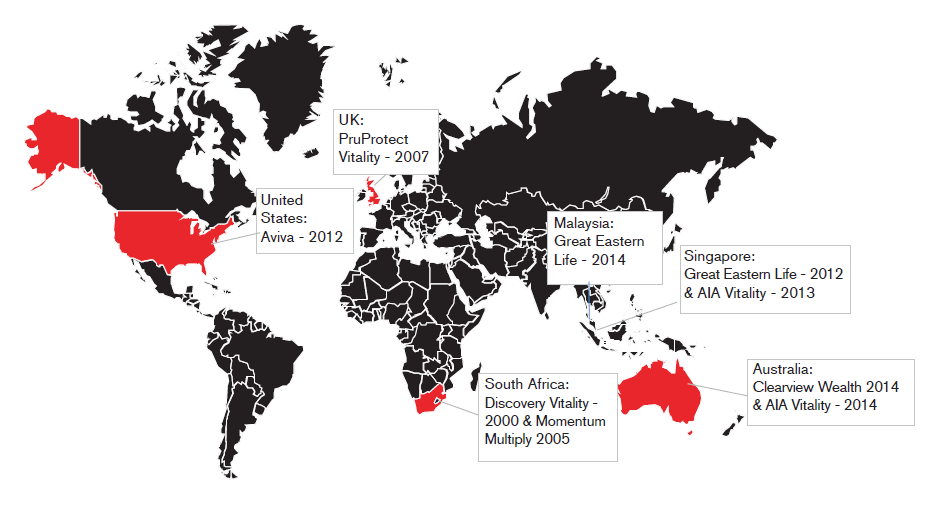
The Discovery Vitality wellness program was launched in 1997 in South Africa and began integrating life insurance discounts with wellness program participation in 2000. [38] Discovery Vitality members earn discounts on items including food, exercise equipment, travel and other consumer goods based on their Vitality status. Status is earned by completing health assessments and making healthy choices such as purchasing healthy food, quitting smoking, losing weight and exercising. [39]
The Vitality wellness program is integrated with Discovery’s life insurance; participating members receive an initial premium reduction of 17.5% on a standard life insurance plan. Future premium discounts ranging from 15% to 18.25% are determined by the policyholder Vitality status; more engaged wellness participation leads to lower premiums. Members are also eligible for a Payback Benefit of 5% to 25%, which is a cashback bonus of total premiums paid every fifth year based on their program status.
Discovery Vitality has furthered its wellness initiatives by partnering with other companies around the world. In the U.K., the Vitality Group teamed up with Prudential to create PruProtect Vitality in 2007. Through PruProtect, all of Prudential’s serious illness, life and income protection (disability income) plans are offered with a wellness component. The PruProtect program offers cumulative premium discounts up to 3% at the end of every year, based on program participation. For example, a policyholder who maintains platinum status for 25 years will pay less than half the premium that year than at policy inception.[40]
Additional discounts and cashback bonuses are available by enhancing the wellness component and paying a monthly fee. This program offers an upfront premium discount ranging from 5 to 40%, based on the term length of the policy or the issue age of the policyholder. Product discounts, cashback, and future premium discounts are based on continued participation in the wellness program, as reflected in program status.[41]
AIA Insurance partnered with the Vitality group to enter Singapore [42] and Australia.[43] AIA offers wellness programs in conjunction with life, critical illness, disability and health insurance. The setup of AIA Vitality-Australia is very similar to the core Discovery Vitality product with premium discounts every year, ranging from 6% to 8.5%, and a cashback component based on a percentage of total premiums, of 2% to 10%, paid every fifth year. The initial premium discount is 7.5% and changes at renewal based on the policyholder’s status.[44]
Several other companies have developed individual protection insurance premium discounts based on wellness program participation. South Africa-based Momentum offers a wellness benefit, called Multiply, that can be purchased with its Myriad life insurance product. With a Multiply membership, Myriad policyholders can earn a discount of 10% to 60% off of their monthly premiums based on their status and fitness levels. Status is earned by staying active and monitoring fitness (physical and even financial fitness). An additional fitness discount is determined by the number of steps the policyholder takes each day, gym visits and fitness assessment results. [45] Great Eastern Life in Singapore offers a 15% premium discount for the first two on years certain plans. In order to qualify, the policyholder must register online and complete a wellness profile annually. Results from an annual health assessment must also fall within the acceptable range in order for the policyholder to qualify for the discount. [46] Additionally, Great Eastern Life offers a wellness program with early critical illness coverage for medically substandard lives in Malaysia. Customers with elevated BMI, cholesterol and/or blood pressure can receive standard rates and qualify for discounts if wellness goals are attained after two years.[47]
ClearView Wealth of Australia gives a 10% initial premium discount. To remain eligible for the discount, a health questionnaire needs to be completed every two years; otherwise the discount declines by 1% each year the insured is still participating in the wellness program. Further premium discounts are given if the policyholder has followed his or her doctor’s advice with respect to exercise or diet.[48] In 2012, Aviva Life in the U.S. started its Wellness for Life program, which is now offered through Accordia Life. [49] [50] The Wellness for Life program offers premium discounts on life insurance plans to policyholders who maintain a healthy weight and have a physical examination at least every other year. [51]
Conclusion
As the costs of chronic disease rise and technology offers expanded personal activity tracking capabilities, health insurers and wellness companies have developed programs to incentivize healthier lifestyle behaviors. These programs encourage participants to increase physical activity, improve nutrition, and reduce tobacco and alcohol use. The effectiveness of these programs is difficult to measure; however, there is evidence that incentivized wellness plans are effective in engaging participation and lowering healthcare costs.
Wellness programs are often a part of a corporate benefits package that may include a group life insurance or disability benefit. Beyond lowering healthcare costs, corporate wellness program offerings could help insurers by informing more refined pricing of these products and enabling more efficient underwriting. As these programs have developed, wellness offerings associated with individual protection insurance policies are a growing trend in the insurance industry. Wellness program offerings linked to insurance can improve customer loyalty and encourage healthier people to purchase these policies.









